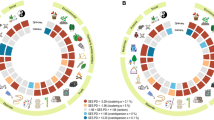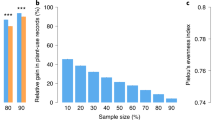Abstract
Advances in biodiversity science, coupled with new technologies and big data platforms, are expanding our ability to explore and understand the natural world. For the first time, biologists can link data from growing repositories and computational approaches to better integrate plant evolution and ecology at the broadest extents. The emerging synthesis is reshaping our views of plant diversification and guiding new approaches to conservation.
This is a preview of subscription content, access via your institution
Access options
Access Nature and 54 other Nature Portfolio journals
Get Nature+, our best-value online-access subscription
$29.99 / 30 days
cancel any time
Subscribe to this journal
Receive 12 digital issues and online access to articles
$119.00 per year
only $9.92 per issue
Buy this article
- Purchase on Springer Link
- Instant access to full article PDF
Prices may be subject to local taxes which are calculated during checkout

Similar content being viewed by others
References
Darwin, C. On the Origin of Species (John Murray, London, 1859).
GenBank (National Institutes of Health); https://www.ncbi.nlm.nih.gov/genbank/
Hinchliff, C. E. et al. Synthesis of phylogeny and taxonomy into a comprehensive tree of life. Proc. Natl Acad. Sci. USA 112, 12764–12769 (2015).
GBIF (Global Biodiversity Information Facility); https://www.gbif.org/
iDigBio (National Science Foundation); https://www.idigbio.org/
Paleobiology Database (National Science Foundation); https://paleobiodb.org/#/
Neotoma Paleoecology Database (Neotoma); https://www.neotomadb.org/
TRY: Plant Trait Database (Future Earth & Max Planck Institute); https://www.try-db.org
WorldClim Version2 (Feed the Future); http://worldclim.org/version2
SoilGrids (ISRIC); https://soilgrids.org
HydroSHEDS (WWF); https://www.hydrosheds.org/
Paleoclimate Modelling Intercomparison Project (WCRP & IGBP); https://pmip.lsce.ipsl.fr/
Jetz, W., McPherson, J. M. & Guralnick, R. P. Integrating biodiversity distribution knowledge: toward a global map of life. Trends Ecol. Evol. 27, 151–159 (2012).
Catalogue of Life (Species 2000 & ITIS); http://www.catalogueoflife.org/
Lifemapper (National Science Foundation); http://lifemapper.org/
BIEN (NCEAS); http://bien.nceas.ucsb.edu/bien/
Cavender-Bares, J. et al. Evolutionary legacy effects on ecosystems: biogeographic origins, plant traits and implications for management in the era of global change. Annu. Rev. Ecol. Evol. S. 47, 433–462 (2016).
Gei, M. et al. Legume abundance along successional and rainfall gradients in Neotropical forests. Nat. Ecol. Evol. 2, 1104–1111 (2018).
Zanne, A. E. et al. Functional biogeography of angiosperms: life at the extremes. New Phytol. 218, 1697–1709 (2018).
Schweiger, A. K. et al. Plant spectral diversity integrates functional and phylogenetic components of biodiversity and predicts ecosystem function. Nat. Ecol. Evol. 2, 976–982 (2018).
Lu, L.-M. et al. Evolutionary history of the angiosperm flora of China. Nature 554, 234–238 (2018).
Thornhill, A. H. et al. Continental‐scale spatial phylogenetics of Australian angiosperms provides insights into ecology, evolution and conservation. J. Biogeogr. 43, 2085–2098 (2016).
Thornhill, A. H. et al. Spatial phylogenetics of the native California flora. BMC Biol. 15, 96 (2017).
Allen, J. M. et al. Spatial phylogenetics of Florida vascular plants: The effects of calibration and uncertainty on diversity estimates. iScience (in the press).
Wickett, N. J. et al. Phylotranscriptomic analysis of the origin and early diversification of land plants. Proc. Natl Acad. Sci. USA 111, E4859–E4868 (2014).
The Angiosperm Phylogeny Group et al. An update of the Angiosperm Phylogeny Group classification for the orders and families of flowering plants: APG IV. Bot. J. Linn. Soc. 181, 1–20 (2016).
Eiserhardt, W. L. et al. A roadmap for global synthesis of the plant tree of life. Am. J. Bot. 105, 614–622 (2018).
Testo, W. & Sundue, M. A 4000-species dataset provides new insight into the evolution of ferns. Mol. Phylogenet. Evol. 105, 200–211 (2016).
Rose, J. P. et al. Shape analysis of moss (Bryophyta) sporophytes: Insights into land plant evolution. Am. J. Bot. 103, 652–662 (2016).
Willis, K. J. (ed.) State of the World’s Plants 2017 (Royal Botanic Gardens, Kew, 2017).
Jetz, W. et al. The global diversity of birds in space and time. Nature 491, 444–448 (2012).
Quintero, I. & Jetz, W. Global elevational diversity and diversification of birds. Nature 555, 246–250 (2018).
Roelants, K. et al. Global patterns of diversification in the history of modern amphibians. Proc. Natl Acad. Sci. USA 104, 887–892 (2007).
Wang, H. et al. Rosid radiation and the rapid rise of angiosperm-dominated forests. Proc. Natl Acad. Sci. USA 106, 3853–3858 (2009).
Schneider, H. et al. Ferns diversified in the shadow of angiosperms. Nature 428, 553–557 (2004).
Moreau, C. S. et al. Phylogeny of the ants: diversification in the age of angiosperms. Science 312, 101–104 (2006).
Winter, M. et al. Phylogenetic diversity and nature conservation: where are we? Trends Ecol. Evol. 28, 199–204 (2013).
Mazel, F. et al. Conserving phylogenetic diversity can be a poor strategy for conserving functional diversity. Syst. Biol. 66, 1019–1027 (2017).
Acknowledgements
We would like to thank J. Cavender-Bares for helpful comments and commentary. This work was supported in part by the US National Science Foundation (grant nos. EF-1115210, DBI-1547229, DBI-1458640, DEB-1442280 and DEB-1208809), the US Department of Energy (grant no. DE-SC0018247), and a seed grant from the University of Florida Biodiversity and Informatics Institutes.
Author information
Authors and Affiliations
Contributions
All authors contributed in writing the manuscript.
Corresponding authors
Ethics declarations
Competing interests
The authors declare no competing interests.
Additional information
Publisher’s note: Springer Nature remains neutral with regard to jurisdictional claims in published maps and institutional affiliations.
Rights and permissions
About this article
Cite this article
Allen, J.M., Folk, R.A., Soltis, P.S. et al. Biodiversity synthesis across the green branches of the tree of life. Nature Plants 5, 11–13 (2019). https://doi.org/10.1038/s41477-018-0322-7
Received:
Accepted:
Published:
Issue Date:
DOI: https://doi.org/10.1038/s41477-018-0322-7
This article is cited by
-
Bridging global knowledge gaps in biodiversity databases: a comprehensive data synthesis on tree diversity of India
Biodiversity and Conservation (2023)
-
Predicting species distributions and community composition using satellite remote sensing predictors
Scientific Reports (2021)



